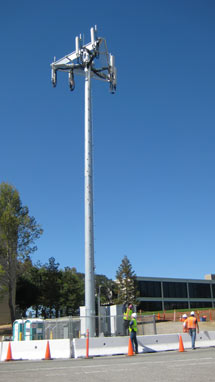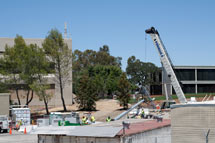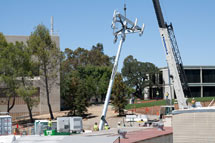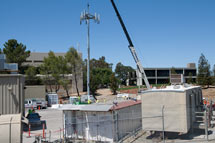
Handy Links
SLAC News Center
SLAC Today
- Subscribe
- Archives: Feb 2006-May 20, 2011
- Archives: May 23, 2011 and later
- Submit Feedback or Story Ideas
- About SLAC Today
SLAC News
Lab News
- Interactions
- Lightsources.org
- ILC NewsLine
- Int'l Science Grid This Week
- Fermilab Today
- Berkeley Lab News
- @brookhaven TODAY
- DOE Pulse
- CERN Courier
- DESY inForm
- US / LHC
SLAC Links
- Emergency
- Safety
- Policy Repository
- Site Entry Form

- Site Maps
- M & O Review
- Computing Status & Calendar
- SLAC Colloquium
- SLACspeak
- SLACspace
- SLAC Logo
- Café Menu
- Flea Market
- Web E-mail
- Marguerite Shuttle
- Discount Commuter Passes
-
Award Reporting Form
- SPIRES
- SciDoc
- Activity Groups
- Library
Stanford
Around the Bay
New AT&T Cell Tower Online
AT&T customers should have noticed an improvement in their cell phone signal at SLAC beginning late last week. A temporary cell tower, which went up behind Building 50 late last month, now provides service to the SLAC campus and immediate surrounding areas. A permanent tower will be installed on the roof of Building 50 after a seismic retrofit of the building is completed, within the next year.
The permanent tower will improve coverage even more; the temporary tower will not have the full coverage on the north side of the SLAC campus that is expected once the permanent one is in place.
Earlier in July, the California Highway Patrol submitted their approval of the tower after "E911" emergency services locator testing and surveys of the coverage were completed. After minor delays in connecting the base station at SLAC and the Mobile Telephone Switching Office for the area, the tower went live Thursday.
According to responses from a 2009 staff survey, about 48 percent of SLAC employees use AT&T as their cell phone provider. More than a third of those who responded reported having zero "bars" of service in many areas of the lab campus.
"The results indicated a lot of dissatisfaction, and there was much interest in putting a tower on site," said telecommunications manager and project leader Les Cottrell. Having the tower on site also alleviates safety concerns, as it will allow better communication in the event of an emergency, especially in places around SLAC notoriously known as cell phone coverage "dead zones."
After months of negotiations with several companies, SLAC reached an agreement with AT&T. AT&T provided approximately $500,000 in materials, labor and services to pay for the tower and the construction, which took the financial burden off of SLAC and the Department of Energy.
"We faced some unique difficulties, but we'd like to acknowledge our partnership with AT&T, who made this project happen out of an abundance of good will," said Chief Information Officer Donald Lemma. Complexities that arose during the project included seeking separate approvals from the Department of Energy, the Federal Aviation Administration and the Federal Communications Commission, among others.
"To go from concept, to approval and construction completion in seven months is unprecedented," Lemma said. He would also like to extend his thanks to the Environment, Safety & Health division, Facilities staff and his IT team who worked tirelessly to complete the project.
The tower will affect only cell phones with AT&T service. T-Mobile and Sprint also have antennas on site, while Verizon Wireless has discussed turning on a tower on the Stanford main campus in the near future, Lemma said. He added that it is unclear whether that coverage would extend to the SLAC site, and that they have been, thus far, unwilling to add a tower on the SLAC campus. Finally, he cautioned that due to the unusual terrain, there may still be some areas with low signal coverage.
SLAC does not recommend or endorse any cell phone providers. SLAC employees considering a cell phone provider are encouraged to speak with coworkers to see how well they receive cell signals on the SLAC campus, as it is unlikely there will be further improvements or signal penetration in the foreseeable future.
Player video of the tower going up is available for download (15 MB, requires Real Player). (Video by Les Cottrell and Mike Hogaboom.)
—Lauren Rugani
SLAC Today, July 26, 2010



